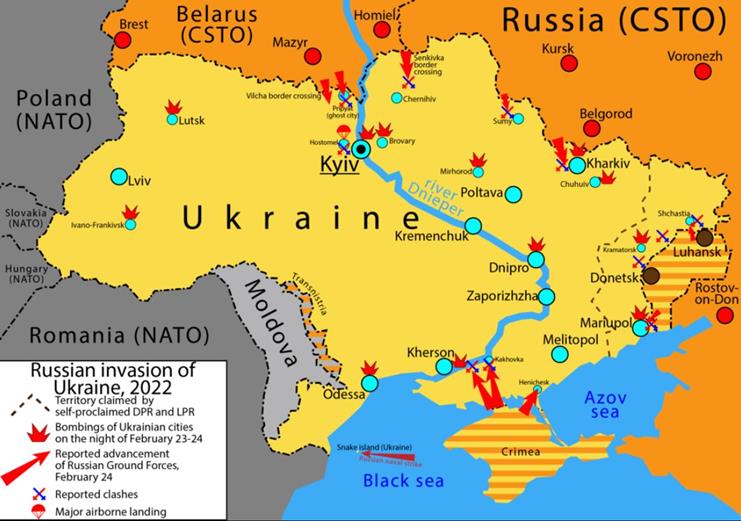The issue of what constitutes an invasion is no longer relevant as of 5 a.m. Moscow time on Feb. 24, 2022, when Russia attacked Ukraine across several fronts with troops, armor, and missile strikes. Indignant Western rhetoric aside, the Russian military’s strategic objective and President Vladimir Putin’s subsequent long-term political objective are what matters now.
The situation is extremely fluid, and three partially overlapping scenarios are possible.
The maximalist scenario would entail Russia taking physical possession of most of Ukraine. The “Banderistan” in the west—roughly one-fifth of the country (Galicia, Podolia, and Sub-Carpathia, marked in blue and green on this excellent Italian map)—would then become an overt NATO protectorate. Following regime change in Kiev, the rest of Ukraine would become a Finlandized, demilitarized buffer, while the east, including Donetsk and Lugansk, would remain nominally independent Russian protectorates. Extreme Western sanctions would be applied against Russia, including its exclusion from the international banking system, Swift—but Putin expects that anyway.
By the end of the first day of operations, it was confirmed that Russian airborne units had captured the Gostomel airfield, just north of Kiev. That may indicate that this maximalist scenario is in the cards, in which case the ground forces from Belarus need to reach the base sometime tomorrow.
The intermediate scenario would include establishing an overland corridor from the Crimea to the Donbass, extending it westward to include the North Crimean Canal at the mouth of the Dnieper river, and possibly advancing to the major Black Sea Port of Odessa. It is militarily less risky but would carry the same political and economic cost, including the imposition of the entire gamut of Western sanctions.
This scenario would leave an embittered government in Kiev still able to regroup and rearm with U.S./NATO help. A long stalemate would follow, energy prices in Europe would skyrocket, and Washington’s sway over Europe would be solidified. This is nevertheless a highly probable scenario, not because it is geopolitically optimal but because it would reflect an internal compromise between several divergent elements of the power structure in Moscow.
The minimalist scenario would expand the Donbass to the administrative borders of the two separatist regions of Donetsk and Lugansk, stopping there. This would be fairly easy for the Russian military to accomplish but would be a disaster for Putin both politically and geostrategically.
The sanctions would still apply, albeit perhaps not to the same extent. There would be no fundamental shift in the military balance on the ground, however, and Putin would be seen as hesitant, weak even, both by his enemies and by his base at home. This is the least likely scenario.
If I were a betting man, I would say the odds on the above three scenarios are 40 percent for the first two, 20 percent for the last one. By this time tomorrow we should know.
Come what may, the danger of a wider war is minimal. The U.S. and NATO have sought to penetrate Ukraine for the past two decades and, since the Kiev coup in February 2014, to steer it onto a collision course with Russia. It is now clear that Ukraine will never join NATO and that not a single soldier of the Alliance will be sent to defend it.
Cui bono? China certainly, the Beltway Swamp probably, the Muslim world to some extent.
For China it is a boon for the U.S. to be focused on a nonthreat in Eastern Europe, away from where the real action is in the Indo-Pacific.
For the military-industrial-congressional complex in Washington it is a win-win situation to have a crisis which ostensibly fortifies American control over Europe, creates new problems for Russia, generates additional demand for military hardware, extends the life of an otherwise obsolete NATO, and deepens the wedge between Berlin and Moscow.
For the Muslim world, and in particular for President Erdoğan in Turkey and the mullahs in Iran, the infidels bickering among themselves creates significant new maneuvering space. In Erdoğan’s case, this is a fresh opportunity to play both sides at a time when he faces significant domestic challenges, both economic and social.
For everyone else, the events in Ukraine are a needless, even tragic, minus-sum game.
